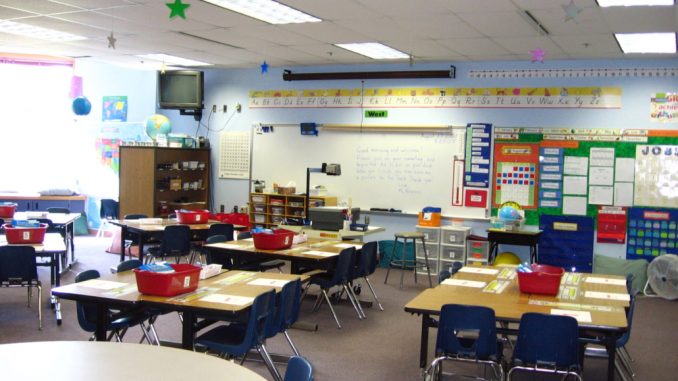
The past nine months have seen more than a quarter-million Americans die from the coronavirus. Each and every death represents a tragedy — a life cut short, an empty place at the family table this holiday season, children mourning their parents, even parents mourning their children.
But a separate and ongoing tragedy has also struck at countless more than another quarter-million Americans: Children who have disappeared from school following last spring’s COVID-19 closures. A survey conducted by CBS’s “60 Minutes” found that among 78 of the largest school districts in the country, at least 240,000 students remained unaccounted for when school resumed, in many cases virtually, this fall. This number doesn’t, of course, include the many other children schools have lost in other districts.
Each and every one of those cases also represents a tragedy. Indeed, it’s a slow-moving crisis. Every child who doesn’t return to school to complete his or her education represents dreams unfulfilled. It means diminished career prospects, lower earnings, an increased risk of trouble with law enforcement or substance misuse, more expense to society through the criminal justice and welfare systems, and on, and on, and on.
Just as these students have fallen through the proverbial cracks, however, policymakers do not seem to be doing nearly enough to solve the problem.
Obstacles to Online Learning
In their reporting on these missing children, “60 Minutes” spoke with one of them, a high school senior in Tampa, Fla. named Kiara. Kiara said she had moved around town eight or nine times since elementary school; her stepfather lost her job when the pandemic hit, and she was currently living in a motel.
A school district administrator said Kiara had been a good student before the pandemic but started failing classes when learning went virtual. Listening to her describe her situation, it’s not hard to figure out why her performance suffered:
Not having that teacher to really talk to was kinda difficult and just me not having a laptop at the time was difficult doing it on my phone. Just such a small screen. …
[Doing virtual learning via her phone] was very difficult because my phone is really skinny. At the time, I didn’t have glasses so I’d have to, like, slide to the left and slide to the right and slide up. So it was just really iffy. …
Definitely, I definitely come outside [to escape her crowded motel room]. I’ll sit here and study. But sometimes, you know, the mosquitoes are coming, you know. It’s hard.
At times, Kiara would walk a mile to a nearby park to get some peace and quiet to complete her work — but the park didn’t have WiFi or an electrical outlet. She said she would “try to make it work as best I could,” but it doesn’t take a doctorate in education to realize why any student’s performance would suffer in that environment.
In some respects, Kiara represents one of the luckier victims of the school shutdowns. She has big dreams — she wants to become a dental hygienist, and eventually a dentist — and fought through the obstacles the COVID-19 closures put in her path. But it’s sadly understandable to see how some families and some children would just give up.
Enrollment Down, and It’s Not All Homeschooling
Across the country, public school enrollment has declined for the current academic year. Outside D.C., Montgomery County, Maryland’s public school enrollment declined by 3,300, or about 2 percent, this fall; on the other side of the Potomac River, Fairfax County, Virginia’s enrollment declined by nearly 5 percent. In Missouri, public school enrollment dropped 3.2 percent statewide, with a 31 percent drop in preschool enrollment and a nearly 10 percent decline in kindergarten enrollment.
These changes represent two distinct trends — both ends of the proverbial barbell. In Montgomery County, Fairfax County, and other wealthy enclaves, the enrollment declines come from affluent families enrolling their children in private schools to escape another year of virtual or hybrid learning in public education. At the other end of the spectrum, children like Kiara in families facing financial and other logistical difficulties dropped out of virtual learning entirely.
Open the Schools
The chaos children like Kiara continue to face with virtual learning — a national scandal if there ever was one — argues for a major expansion of school choice, so that no child faces these kinds of obstacles again. Thankfully, Ohio just enacted a major expansion of school choice, giving students an early Christmas present; other states should follow suit (in the interests of full disclosure, I have worked on a variety of projects advocating for school choice; however, no clients had input into this article).
Until every parent has access to school choice, school districts should start taking steps to reopen their classrooms to in-person instruction. There are fine and valid disagreements to be had over the necessity of business closures during the pandemic, but the idea that bars should remain open yet schools remain closed runs counter to any sense of logic, not to mention good public policy.
The future of hundreds of thousands of children lies in the hands of policymakers and school officials coming up with a plan to open their doors as soon as possible, and keep them open. Kiara and students like her deserve far better than what they have received during the past nine months — and they deserve it now.
Via The Federalist
